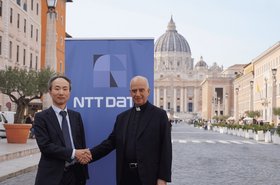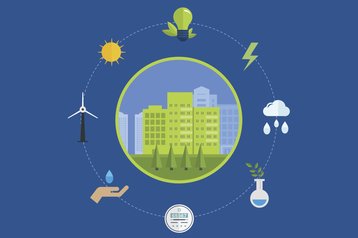Data centers are the backbone of our digital economy, fueling the insatiable demand for smart devices, remote work, and AI-driven applications. Processing more than 2.5 quintillion bytes of data each day, data centers require a significant amount of power.
Yet, as digital dependence grows, our outdated power grid struggles to keep up. This is compounded by the rising use of electric vehicles, extreme weather events, and the expansion of industrial activities, raising urgent questions about how to sustain this rapid expansion.
While many data center companies are turning to alternative energy and looking to improve efficiency, these efforts alone won’t solve the problem. America needs an unprecedented partnership between government, energy providers, and data center operators to secure its digital and economic future.
Grid shortcomings threaten digital growth
Data centers consume roughly two percent of global electricity – a figure expected to climb as our reliance on digital services deepens. Yet, much of the US power grid was built for a different era and is increasingly unreliable and unable to scale.
Renewable sources like wind and solar are vital to our energy future, but aren’t adding enough to the power grid at current levels to solve the issue. Without alternatives and modernization, energy constraints could stall digital progress and drive up costs for businesses and consumers alike.
Building a more resilient and energy-efficient future
The data center industry is making strides to reduce its carbon footprint and strengthen energy resilience. Investments in renewable energy sources like wind and solar have helped ease the burden on traditional power grids, but true sustainability and efficiency requires a multi-faceted approach.
Optimizing cooling systems – a large energy consumer in data centers – is a key part of this effort. Technologies such as liquid cooling, airflow management, heat recovery and real-time monitoring are helping to lower excess energy consumption and improve overall efficiency.
In addition to these innovations, there are new alternative energy options like fuel cells, natural gas generation, and small modular reactors (SMRs) emerging as a promising alternative onsite energy generation. SMRs are interesting because they operate on a smaller scale than traditional nuclear plants, and advancements in technology have made them inherently safer.
In some cases, they can use nuclear waste as fuel, reducing overall waste and presenting a lower risk profile. SMRs also produce a large amount of low-carbon electricity, helping to reduce greenhouse gas emissions. By integrating them into the energy mix, data centers can further enhance their energy efficiency and resilience. These reactors can also support the grid during peak demand times and provide a stable power supply, complementing renewable sources like wind and solar.
These innovations mark significant progress, but no single company or even an entire industry can tackle this challenge alone. Achieving long-term sustainability requires collective action across sectors.
Collaboration is the key to energy security
To modernize the grid, the solution lies in cross-sector partnerships. Utilities, regulators, and the data center industry must work together to adapt our energy infrastructure to the demands of the digital age. By leveraging smart grid technologies, we can make the grid more adaptable to spikes in demand and better integrate renewable energy. Advanced storage solutions, such as battery technologies, could store surplus energy for peak times, easing grid strain and lowering operational costs.
Public-private partnerships hold transformative potential. Collaborative investments in energy infrastructure could accelerate innovation and ensure a stable, sustainable power supply for years to come.
The role of governments and data center clients
A partnership between the data center industry and governments is critical to addressing the dual challenge of powering the digital economy while preserving the integrity of America’s power grid, as former President Biden and now President Trump have both signaled.
Policymakers and operators must collaborate to establish realistic and forward-thinking standards that promote energy efficiency without stifling innovation. From integrating renewable energy to reusing waste heat, these partnerships can drive meaningful sustainability initiatives.
Yet, any regulations must strike a balance between encouraging community benefits while remaining feasible for data center operators managing complex systems. By aligning priorities and fostering dialogue, the industry and government can create a resilient power grid that supports both economic growth and environmental responsibility.
Data center clients: A crucial partnership
Data center clients also have a pivotal role to play. They must ask tough questions: are their servers the most energy-efficient models available? Do all those servers need to run 24/7, or could workloads be consolidated or scheduled more effectively? By upgrading to newer, more efficient hardware and rethinking operational practices, clients can not only cut costs but also reduce the environmental footprint of their digital operations, to benefit us all.
Clients can also collaborate with data center operators to implement energy-saving measures. For example, they can participate in demand response programs, where they agree to reduce their power usage during peak times in exchange for financial incentives. This not only helps stabilize the grid but also promotes a culture of energy efficiency within the industry.
Securing America’s digital future
Power drives the digital ecosystem, and a reliable grid is essential for continued growth. To safeguard our economy, we must modernize energy infrastructure with the same urgency and innovation that has defined the digital revolution.
The data center industry can lead the charge, advancing technologies that support sustainable growth while protecting the environment. But progress hinges on collective action. By aligning government, private energy providers, and industry players, we can seize the opportunity to build a resilient and efficient energy future. The stakes are high, but so are the rewards. If we act decisively, we can ensure a thriving digital economy powered by a grid built for the 21st century.
More from NTT Global Data Centers
-

NTT announces 500MW NAV2 data center in Navi Mumbai, India
Further details have not yet been shared
-

NTT Data partners with Holy See in Japan for digital archive
Will see the two using "advanced technologies" to further archive project
-

NTT launches Kolkata data center campus in West Bengal, India
Company also details upcoming Bengaluru 4 campus


